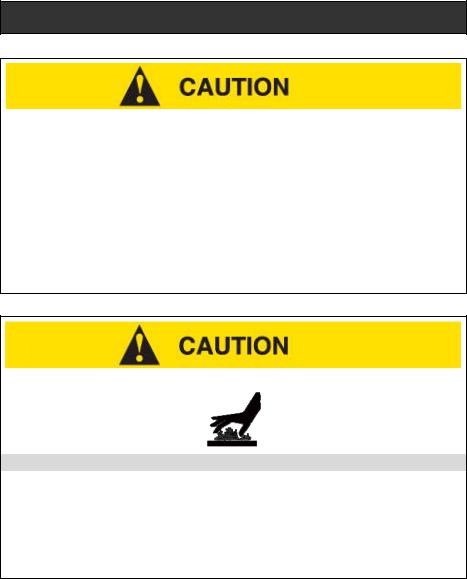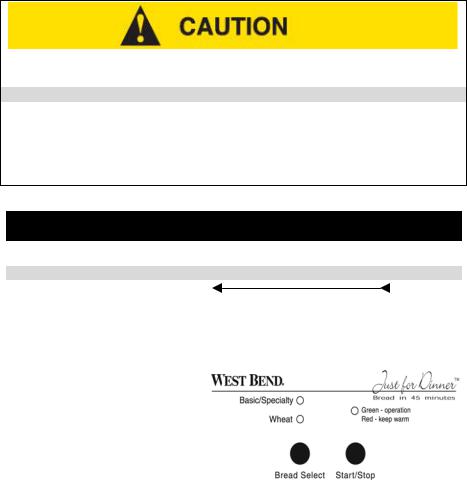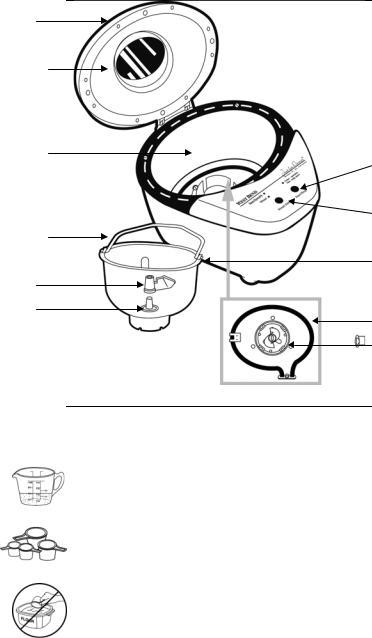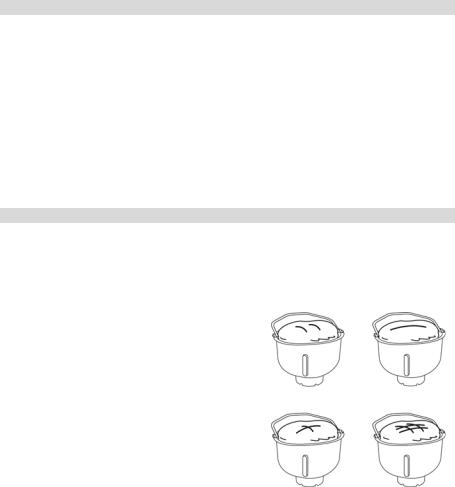West Bend 41077 Owner's Manual

Just For Dinner™ Breadmaker
Instruction Manual
Register this and other West Bend® Housewares products through our website:
www.westbend.com
Important Safeguards............................................................................................... |
2 |
Heat Precautions...................................................................................................... |
2 |
Electricity Precautions .............................................................................................. |
3 |
Precautions For Use Around Children...................................................................... |
4 |
Getting To Know Your Breadmaker ...................................................................... |
4-5 |
Know Your Ingredients .......................................................................................... |
6-8 |
Basic Steps in Making Bread ................................................................................ |
8-9 |
Using Bread Mixes & Adapting Your Own Recipes............................................. |
9-10 |
Cleaning Your Breadmaker .................................................................................... |
11 |
Troubleshooting ................................................................................................ |
11-13 |
Recipes ............................................................................................................. |
14-19 |
Warranty................................................................................................................. |
20 |
SAVE THIS INSTRUCTION MANUAL FOR FUTURE REFERENCE

IMPORTANT SAFEGUARDS
When using electrical appliances, basic safety precautions should always be followed including the following:
•Read all instructions, including these important safeguards and the care and use instructions in this manual.
•Do not use appliance for other than intended use.
•The use of accessory attachments not recommended by West Bend® Housewares may cause injuries.
•Do not operate when the appliance is not working properly or when it has been damaged in any manner. For service information see warranty page.
•Do not attempt to repair this appliance yourself.
•For household use only.
To prevent burns, personal injury or property damage, read and follow all instructions and warnings.
HEAT PRECAUTIONS
•Do not touch hot surfaces. Use handle and knobs where provided. Use hot pads or oven mitts when handling hot surfaces.
•Set breadpan on hot pad, trivet or other heat protective surface. Do not set hot breadpan directly on the counter, table or other surface.
•Do not put hand inside oven chamber after bread pan is removed. Heating unit will still be hot.
2

To prevent electrical shock, personal injury or property damage, read and follow all instructions and warnings.
ELECTRICITY PRECAUTIONS
•To protect against electric shock, do not immerse cord, plugs, or other electric parts in water or other liquids.
•Do not operate any appliance with a damaged cord or plug.
•Do not use electric parts outdoors, or place them on or near a gas or electric burner, in a heated oven, refrigerator or freezer.
•Do not plug cord into wall outlet unless control is set to OFF position.
•Always turn control to OFF and unplug the appliance from outlet when not in use and before cleaning. Allow unit to cool completely before putting or taking off parts and before cleaning.
•Your breadmaker has a short cord as a safety precaution to avoid pulling, tripping or entanglement. Position the cord so that it does not hang over the edge of the counter, table or other flat surface area.
•While use of an extension cord is not recommended, if you must use one, make sure the cord has the same or higher wattage as the breadmaker (wattage is stamped on the underside of the breadmaker). Arrange the extension cord to avoid pulling, tripping or entanglement. Position the extension cord so that it does not hang over the edge of the counter, table or other flat surface area.
•Use an electrical outlet that accommodates the polarized plug on the breadmaker. On a polarized plug, one blade of the plug is wider than the other. If the plug does not fit fully into the outlet or extension cord, reverse the plug. If the plug still does not fit fully, contact a qualified electrician. Do not alter the plug.
•Do not use an outlet or extension cord if the plug fits loosely or if the outlet or extension cord feels hot.
•Keep the cord away from hot parts of the appliance and hot surfaces during operation.
•Do not use your breadmaker with a converter or transformer. This will destroy the electronic controls.
3

To prevent burns or other personal injuries to children, read and follow all instructions and warnings.
PRECAUTIONS FOR USE AROUND CHILDREN
•Always supervise children.
•Do not allow children to operate or be near the breadmaker, as the outside surfaces are hot during use.
•Do not allow cord to hang over any edge where a child can reach it. Arrange cord to avoid pulling, tripping or entanglement.
SAVE THESE INSTRUCTIONS
GETTING TO KNOW YOUR BREADMAKER
The control panel on your bread maker was designed to be very easy to use. Please review the following features to better understand the control panel.
Bread Select Button: The Bread Select button lets you choose between two bread settings – Basic/Specialty and Wheat. With each press of the Bread Select button, the light will alternate between the two bread settings.
The Basic/Specialty setting can be used for almost any bread recipe containing mostly bread flour. If a recipe contains up to 50% wholewheat flour, use the Wheat setting. An alert will sound near the end of the rise cycle (about 22 minutes after machine started) to perform crust treatment if desired.
Start and Stop Button: Before starting the machine, you must first program desired Bread Select setting. Then press Start/Stop button once to turn machine on. When the machine is on, green “operation” light will glow. When bread is done, light will change to red to let you know machine is in “keep warm” mode for one hour. Alert will also sound when bread is done. Turn off by holding Start/Stop button until alert sounds and “keep warm” light goes out. If machine is not turned off after completion of one-hour “keep warm” period, machine will automatically turn itself off.
4

Breadmaker Parts
Cover
Viewing
Window
Oven
Chamber
Handle
Knead
Bar
Drive
Shaft
Remember To:
Start/Stop
Button
Bread
Select
Button
Bread Pan
Heating Unit
Bread Pan
Attachment
•Always measure liquid ingredients in see-through measuring cups with graduated markings. Always use liquids between 8090°F.
•Always spoon dry ingredients into marked measuring cups or spoons, then level off with table knife.
•Never scoop measuring cups into dry ingredients. Packed ingredients cause dry, short loaves.
5

KNOW YOUR INGREDIENTS
Although bread making seems very basic, it is a science and the proportions of ingredients are critical. Read the following information to better understand the importance each ingredient plays in the bread making process. Always make sure the ingredients are fresh.
BREAD FLOUR should be used in your bread maker. It contains more glutenforming proteins than all-purpose flour and will provide well-formed loaves with good structure. Several different brands of bread flour are available. Do not use selfrising or cake flour in your bread maker.
WHOLE WHEAT FLOUR can be used in combination with bread flour at the Wheat bread setting. Up to 50% wheat flour can be used in recipes. Do not attempt to use all whole-wheat flour in recipes, as poor results will be obtained.
RYE FLOUR can be used in combination with bread flour in the preparation of rye bread. Do not use all rye flour in recipes as poor results wil be obtained.
How to make minor adjustments to dough: All flours are affected by growing conditions, milling, storage, humidity, etc. While not visibly different, you may need to make some minor adjustments when using different brands of flour as well as compensating for the humidity in your area. Always store flour in an airtight container. Store whole grain flours (whole wheat, rye) in a refrigerator to prevent them from becoming rancid.
Measure the amount of flour as directed in each recipe but make any adjustment after the first 3 to 4 minutes of continuous kneading. Do not turn machine off to adjust dough. Check the condition of the dough by touching and looking at it during the knead cycle. This is the only time you can make any minor change.
•Open cover and touch dough. If it feels a little sticky and there is a slight smear under the knead bar, no adjustment is necessary.
•If dough is very sticky, clinging to the sides of pan, and is more like a batter than a dough, add one tablespoon of flour. Allow to work in before making any further adjustments. Open cover only to add flour.
•If dough is dry and the machine seems to be laboring, add one-teaspoon lukewarm water at a time. Allow water to work into dough and keep cover closed before making any further adjustment.
•You will know when the dough is just right near the end of the knead cycle when it is soft to the touch, smooth in appearance and just a bit sticky, leaving a slight residue on your finger. The bottom of the bread pan will also be clean or almost clean of any dough residue.
Do not exceed 1⅓ cups of bread flour for the dinner size loaf. Breads containing a combination of flours, cereals or oats should not exceed a total of 1½ cups.
SUGAR and OTHER SWEETENERS provide food for the yeast, add height and flavor to the bread and give the crust a golden color. Types of sweeteners that can be used include sugar, brown sugar, honey, molasses, maple syrup, corn syrup and fruits (dried or fresh).
A special tip when measuring sticky sweeteners is to first coat the measuring spoon with vegetable oil. Sweeteners slide right out.
6
Do not use artifical sweeteners as a substitute for sugars and other natural sweeteners as the yeast will not react properly and poor results will be obtained.
MILK enhances flavor and increases the nutritional value of bread. Any type of milk (whole, 2%, 1%, skim, buttermilk or canned evaporated milk) can be used in making bread. Refrigerated mik must always be warmed to 80-90°F. Warm in a glassmeasuring cup in microwave or in a small pan on top of the range. Do not heat milk above 110°F as this could affect the yeast.
WATER used in combination with dry milk can be substituted for regular milk. Use lukewarm water, about 80-90°F. Do not use water above 110°F as this could affect the yeast.
Using too much liquid can cause the bread to collapse during the bake cycle. During humid weather, slightly less liquid may be needed, as the flour will absorb moisture from the air. In dry weather, slightly more liquid may be needed as flour can lose moisture. When a severe change in weather occurs, it is best to check the condition of the dough during the knead cycle as noted in the “How to make minor adjustments to dough” section.
Water and milk are, for the most part, interchangeable in recipes. Eliminate dry milk in recipes when substituting milk for water. Watch condition of the dough during the knead cycle for any minor adjustment that may be needed. Slightly more milk may be needed when substituting for water.
BUTTER, MARGARINE, SHORTENING and OILS serve several purposes in bread making as they tenderize the bread, add flavor and richness. Butter and margarine are interchangeable in recipes. You may wish to cut these fats into two pieces for faster blending during the knead cycle.
Low-fat or fat-free bread can be made by substituting equal amounts of unsweetened applesauce or plain yogurt for the amount of fat recommended in the recipe. Watch dough as it kneads for any minor adjustment, which may be needed. Using less fat will affect the height, tenderness and texture of the bread, which is normal.
EGGS add color, richness and leavening to bread. Use large eggs. No premixing is needed. Egg substitutes can be used in place of fresh eggs. One egg equals ¼ cup of egg substitute. To reduce cholesterol, you can substitute two (2) egg whites for a large egg in recipe without affecting the end result. Watch the dough during the knead cycle as some minor adjustment may be needed to get the dough to the right consistency.
A special tip when using eggs is to run them under warm water for about 10-20 seconds before cracking. This helps the egg slide out of shell better.
SALT has several functions in making bread. It controls yeast growth while strengthening the gluten structure to make the dough more elastic and adds flavor. Use ordinary table salt in your bread maker. Using too little or eliminating the salt will cause the dough to over rise. Using too much can prevent the dough from rising as high as it should. “Light” salt can be used as a substitute for ordinary table salt, providing it contains both potassium chloride and sodium. Use the same amount as recommended for table salt.
7

YEAST is a living organism, which, through fermentation feeds on carbohydrates in flour and sugar to produce carbon dioxide gas that makes the bread rise. Fast rising or bread machine yeast must be used in your bread maker for best results in the 45-minute cycle. Do not use active dry or compressed yeast, as poor results will be obtained.
A ¼-ounce package of fast rising or bread machine yeast contains 2¼ teaspoons, the exact amount needed when making scratch recipes. Yeast can also be purchased in glass jars so you can measure the exact amount needed. Once jar is opened, keep refrigerated. Always make sure yeast is fresh and has not passed the “use by” date.
SPECIAL NOTE ON CINNAMON AND GARLIC: Adding too much cinnamon or garlic can affect the texture and size of the loaf obtained. Cinnamon can break down the structure of the dough, affecting height and texture. Too much garlic can inhibit the yeast activity. Use only the amount of cinnamon and garlic recommended in the recipe.
BASIC STEPS IN MAKING BREAD
Always clean your new appliance thoroughly before using. Refer to “Cleaning Your Breadmaker” section.
1.Position knead bar onto shaft in bottom of pan, matching hub shape with shaft shape. You may need to twist bar slightly to drop in place. Make sure knead bar is pushed down onto shaft all the way.
2.Add ingredients to pan in order listed in recipe, liquids first, then the butter or margarine, next the dry ingredients and finally the yeast. It is best to level the dry ingredients before adding the yeast.
3.Postion pan into bread maker and turn in direction of arrow (counterclockwise) to lock in place. If pan does not lock securely, remove and reposition until secured. Pan must always be locked in place for bread maker to function. Close cover.
4.Plug bread maker cord into a 120 volt AC electrical outlet ONLY. Alert will sound. Press Bread Select button for type of bread being made. Press Start/Stop once to turn machine on. Green “operation” light on control panel will glow.
After bread maker has been turned on, programmed setting cannot be changed. To change setting, hold Start/Stop button down until alert sounds and green “operation” light goes out. Then program control as desired and turn back on. The bread making process will begin and green “operation” light will glow. The dough will knead, rise and bake all in 45 minutes.
A few minutes before the bread starts to bake (22 minutes after machine is turned on), an alert will sound to perform crust treatment if desired (see pg. 10).
5.When bread is done, alert will sound and red light for “keep warm” will glow on control panel. Turn bread maker off by holding Start/Stop button down until alert sounds and red “keep warm” light goes out. Unplug cord from electrical outlet. It is best to remove bread immediately for a crispier crust. Open cover and remove pan using oven mitt or hot pad, turning to right, (clockwise) to unlock.
If bread is not removed right after cycle is complete, it will automatically go into
8

one hour “keep warm” mode. If machine is not turned off after end of “keep warm” period, machine will turn itself off and red “keep warm” light will go out.
6.Invert bread pan and shake gently until loaf falls out. Place on rack to cool 15 to 20 minutes. Knead bar will normally stay in pan when bread is removed, but may on occasion slide out in the bread. If bar is inside loaf, remove before slicing. If making another loaf of bread right away, be sure machine is turned off and allowed to cool 15 to 20 minutes with cover open. This will ensure proper temperature sensing which is critical for the 45-minute cycle.
High Altitude Adjustment: Reduced air pressure at high altitudes causes yeast gases to expand more rapidly and the dough to rise more quickly. The dough can rise so much that when it begins to bake, it will collapse due to overstretching of the gluten structure. To slow the rising of the dough, reduce the amount of yeast by ¼ teaspoon at a time until you find the right amount. You can also reduce the amount of liquid by a teaspoon or two. Some experimentation will be needed when using your bread maker at high altitudes.
USING BREADMIXES
Pre-packaged bread mixes can be used in your bread maker following the guidelines below. Most bread mixes have a net weight of 14 or more ounces. This will make TWO dinner size loaves of bread. Never attempt to use a full bread mix in your Just for Dinner™ bread maker as it can not make this large a loaf of bread.
1.Before opening blend mix thoroughly.
2.Add ½ cup (4 ounces) of lukewarm water, 80-90°F, to bread pan containing knead bar.
3.Measure 1½ cups of bread mix and add to bread pan, level ingredients.
4.Add packet of yeast from mix PLUS 1 teaspoon fast rising or bread machine yeast. If extra yeast is not used, the loaf of bread will be short. Do not use active dry yeast. (If mix has yeast blended into the dry ingredients, you will still need to add the extra teaspoon of fast rising or bread machine yeast). Yeast does not need to be the same brand as original packet.
5.Lock bread pan into machine and close cover. Program for Basic/Specialty or Wheat, depending on type of mix being used. Turn machine on. After 3 to 4 minutes of kneading, check dough for any minor adjustment that may be needed as bread mixes vary slightly by brand. Do not turn machine off to adjust dough. Crust treatment can be performed when alert sounds just before bake cycle begins.
1.If dough is too dry and motor seems to be laboring, add 1-teaspoon lukewarm water at a time until dough becomes soft and pliable.
2.If dough is too wet and clinging to the side of pan, add 1-tablespoon bread mix or flour, allowing it to be blended into dough before adding more if needed. Dough should gather into a ball and just be sticky to the touch.
3.Do not leave cover open while adjusting dough, as this will allow heat to escape. Open cover only to add ingredients, and then close.
9

6.When done, turn machine off and remove loaf from pan. Allow to cool on rack 15 to 20 minutes before slicing.
Notes: When using the remainder of the bread mix to make another loaf follow the guidelines except add a ¼-ounce package OR 2¼ teaspoons of fast rising or bread machine yeast. This amount will compensate for the packet of yeast used to make the first loaf.
If there is not enough (1½ cups) bread mix left to make a second loaf of bread, use bread flour or all purpose flour to make up the difference.
ADAPTING YOUR FAVORITE RECIPES
After you have prepared some of the recipes in this book, you may wish to adapt some of your favorite bread recipes to the bread maker. Some experimentation will be required on your part and you will need to check the condition of the dough during the knead cycle for any minor adjustment that may be needed in liquid or flour. Use one of the recipes in this book that is similar to your recipe as a guide, or use the formula that follows:
½ cup liquid, 80-90°F (4 ounces) |
1 tablespoon fat |
1 tablespoon sweetener |
1⅓ cups bread flour |
2¼ teaspoons fast rising or bread machine yeast |
¼ teaspoon salt |
CRUST TREATMENT
For a gourmet touch, you can create breads with decorative crusts, whether slashed, slit or sprinkled with seeds, herbs or cheese. Follow these guidelines for the crust treatment of your choice:
Just before bread is baked: When alert sounds just before bread cycle begins, open cover and carefully brush top surface of dough with a lightly beaten egg white mixed with 1-teaspoon water. Slash top of dough with a sharp knife, about ¼ to ½ inch deep for desired design. Leave plain or sprinkle with seeds, herbs, grated Parmesan or Romano cheese or other desired topping. Press topping gently into dough to make sure it will adhere. Close cover and allow bread to be baked. Avoid opening cover during baking to prevent heat loss.
For best results, use only beaten egg white and water mixture to treat crust before bake cycle begins. This mixture will ensure that any topping will stick to the top of the bread and not fall off when loaf is removed from pan.
Slashed Top |
Butter Split Top |
|
|
|
|
X Slashed Top |
Tic-Tac-Toe Top |
|
|
Warning: Do not use vegetable oil cooking sprays for crust treatment, as mixture is flammable when exposed to heating unit in bread maker.
10

After bread is baked: Remove loaf of bread from pan and place on rack to cool. Lightly brush top surface with melted butter, margarine, vegetable or olive oil. Sprinkle with desired seed, herb, cheese, etc. For a simple floured top, just sprinkle top of loaf with flour. No butter, margarine or oil is needed.
CLEANING YOUR BREADMAKER
1.Unplug cord from electrical outlet and allow to cool completely before cleaning.
2.After bread is removed from pan, fill pan half full with warm water and a small amount of dish soap. Set pan in an empty sink or on hot pad and allow pan to soak for 5 to 10 minutes or until knead bar can be lifted off shaft. You may need to twist bar slightly to loosen. The knead bar must soak in water before it can be removed. If knead bar is difficult to remove after soaking, secure cross bar on underside of pan while twisting knead bar to loosen. Wash inside of pan and knead bar with a soft cloth, rinse and dry. Replace knead bar on shaft.
Do not immerse bread pan in water or wash in automatic dishwasher as damage to bearing that turns the knead bar can occur.
Be sure shaft in bottom of pan is kept clean to ensure knead bar fits properly. Do not use any type of utensil or tool to clean
the gasket around the shaft, as damage will occur and result in leakage.
Do not use any abrasive scouring pads or cleansers on bread pan or knead bar as damage to coating or finish can occur. The coating on the inside of bread pan may change color over time, which is normal and does not affect the bread.
3.Wipe inside of oven chamber and outside surfaces of bread maker with a damp cloth if necessary.
TROUBLESHOOTING GUIDE
Review the following Problems, Possible Causes and Solutions below.
LOAF SIZE & SHAPE
1.Short loaves. On average dinner size loaves will be between 3 and 4 inches high.
•Wheat breads will be shorter than white breads due to less gluten forming protein in whole-wheat flour.
•Not enough liquid - Increase liquid by 1-2 teaspoons.
•Sugar omitted or not enough added - Assemble ingredients as listed in recipe.
•Wrong type of flour used - Do not use all-purpose flour.
•Not enough yeast used or too old. - Measure amount recommended and check freshness date on package.
•Wrong type of yeast used. - Use fast rising or bread machine. Do not use active dry yeast.
2.Flat loves, no rising.
•Yeast omitted - Assemble ingredients as listed in recipe.
11
•Yeast too old - Check expiration date.
•Liquid too hot - Use lukewarm liquids 80-90°F.
•Too much salt added - Use amount recommended.
•Sugar or other sweetener omitted - Assemble ingredients as listed in recipe.
3. Top and sides cave in.
1.Too much liquid – Reduce liquid by 1-2 teaspoons.
2.Too much yeast – Use recommended amount.
4. |
Gnarly knotted top, not smooth. |
• |
Not enough liquid – Increase liquid by 1-2 teaspoons. |
• |
Too much flour. – Measure flour accurately, leveling off measuring cup. |
5. |
Loaves uneven, shorter on one end. |
• |
Dough too dry preventing even rise in pan. – Increase liquid by 1-2 teaspoons. |
6. |
Collapsed while baking. |
• May be caused from baking in high altitude. – Make adjustment for high altitude baking by reducing yeast by ¼ teaspoon and reducing liquid by 1-2 teaspoons.
|
BREAD TEXTURE |
7. |
Heavy, dense texture. |
• |
Too much flour. – Measure accurately, leveling off measuring cup. |
• |
Not enough yeast. – Add recommended amount of yeast. |
• |
Not enough sugar. – Add recommended amount of sugar. |
8. |
Open, coarse, holey texture. |
•Salt omitted. – Assemble ingredients as listed in recipe.
•Too much yeast. – Add recommended amount of yeast.
•Too much liquid. – Reduce liquid by 1-2 teaspoons.
9. |
Bread doesn’t slice well, very sticky. |
• |
Sliced while too hot. – Allow bread to cool on rack at least 15-20 minutes before |
slicing to release steam. |
|
• |
Not using proper knife. – Use good bread knife or electric knife. |
10. |
Center of loaf raw, not baked through. |
•Too much liquid. – Reduce liquid by 1-2 teaspoons.
•Power outage during operation. – If power goes out during operation, bread maker will remain off when power is restored. Remove unbaked loaf from pan and start over with fresh ingredients.
•Forgot to put knead bar in pan. – Always make sure knead bar is on shaft in bottom of pan before adding ingredients.
CRUST and COLOR THICKNESS 11. Dark crust color/too thick.
•Too much sugar. – Reduce sugar by half.
12
12. Loaf of bread is burned.
•Bread maker is malfunctioning. – See Warranty page for service information.
13. Crust too light.
•Not enough sugar or fat. – Increase sugar or fat by half amount recommended.
PAN PROBLEMS 14. Knead bar cannot be removed.
• You must add water to bread pan and allow knead bar to soak before it can be removed. – Follow cleaning instructions. You may need to twist bar slightly after soaking to loosen. Do not immerse bread pan in water.
15. Bread sticks to pan/difficult to shake out.
• Can happen over prolonged use. – Wipe inside of bread pan, from ribs down with vegetable oil/solid shortening, or add 1-tsp. vegetable oil to liquid in pan before adding dry ingredients. Do not use vegetable spray as sticking can worsen. Or, let bread sit in pan for 10 minutes before shaking out. Replacement pan may be ordered. See Warranty section.
|
MACHINE MECHANICS |
16. |
Ingredients not mixed. |
• |
Did not start machine. – After programming control panel, press Start/Stop |
button to turn on. |
|
• |
Forgot to put knead bar in pan. – Always make sure knead bar is on shaft in |
bottom of pan before adding ingredients. |
|
17. |
Burning odor noted during operation. |
•Ingredients spilled inside oven. – Be careful not to spill ingredients when adding to pan as they will burn on heating unit and cause smoke.
•Pan leaks. – Replacement pan may be ordered. See Warranty section.
•Exceeding capacity of bread pan. – Do not use more ingredients than recommended in recipe and always measure accurately.
18.Machine unplugged by mistake or power lost during use. How can I save bread?
•If machine is in knead cycle, reprogram to the same bread setting and turn machine back on.
•If machine is in rise or bake cycle, preheat conventional oven to 350°F. Carefully remove pan from machine and bake on rack in center of oven for 20-25 minutes or until golden brown.
19. Alert sounds, bread select light flashed and machine cannot be turned on.
•Bread maker too hot to make consecutive loaves. – Unplug cord from outlet and allow to cool with pan removed and cover open for 15-20 minutes. Plug cord back in outlet, add pan and start machine.
•Bread maker is malfunctioning. – See Warranty section for service information.
13

RECIPES
Note bread setting and follow “Basic Steps in Making Bread” for recipes below.
OLD FASHIONED WHITE BREAD
Use Basic/Specialty setting
½cup milk 80-90°F (4 ounces)
1tablespoon butter or margarine 1⅓ cups bread flour
1tablespoon sugar ¼ teaspoon salt
2¼ teaspoons (¼-ounce pkg.) fast rising or bread machine yeast.
CLASSIC RYE BREAD
Use Basic/Specialty setting
½ |
cup water 80-90°F (4 ounces) |
1 |
tablespoon butter or margarine |
1 |
cup flour |
⅓ |
cup medium rye flour |
1 |
tablespoon sugar |
1 |
tablespoon dry milk |
¼teaspoon salt
1½ teaspoons unsweetened cocoa (optional)
½teaspoon caraway seed (optional)
2¼ teaspoons (¼-ounce pkg.) fast rising or bread machine yeast.
ITALIAN HERB BREAD
Use Basic/Specialty setting
½ cup water 80-90°F (4 ounces) 1 tablespoon butter or margarine 1⅓ cups bread flour
1 tablespoon sugar
1 tablespoon dry milk
1½ tablespoons grated Parmesan cheese 1 teaspoon Italian seasoning
¼teaspoon salt
2¼ teaspoons (¼-ounce pkg.) fast rising or bread machine yeast.
FRENCH BREAD
Use Basic/Specialty setting
½ cup water 80-90°F (4 ounces) 1½ tablespoons olive or vegetable oil 1¼ cups bread flour
2 teaspoons sugar
¼teaspoon salt
2¼ teaspoons (¼-ounce pkg.) fast rising or bread machine yeast.
14
DILL BREAD
Use Basic/Specialty setting
½ cup water 80-90°F (4 ounces) 1 tablespoon butter or margarine 1⅓ cups bread flour
1 tablespoon sugar
1 tablespoon dry milk
1 teaspoon dried dill weed
¼teaspoon salt
2¼ teaspoons (¼-ounce pkg.) fast rising or bread machine yeast.
GARLIC BREAD
Use Basic/Specialty setting
½cup water 80-90°F (4 ounces) 1 tablespoon butter or margarine 1⅓ cups bread flour
1 tablespoon sugar
1 tablespoon dry milk
1½ teaspoons dried parsley flakes
½teaspoon garlic powder
¼teaspoon salt
2¼ teaspoons (¼-ounce pkg.) fast rising or bread machine yeast.
POTATO BACON BREAD
Use Basic/Specialty setting
½ cup water 80-90°F (4 ounces) 1 tablespoon butter or margarine 1 cup bread flour
¼cup instant potato flakes
1½ tablespoons real or imitation bacon bits 1 tablespoon sugar
1 tablespoon dry milk
¼teaspoon salt
2¼ teaspoons (¼-ounce pkg.) fast rising or bread machine yeast.
SWISS JALAPENO BREAD
Use Basic/Specialty setting
½ cup water 80-90°F (4 ounces) 1 tablespoon vegetable oil
1 cup bread flour
¼cup rye flour
¼cup shredded Swiss cheese 1 tablespoon sugar
1 tablespoon dry milk
1-2 teaspoons jalapeno peppers, chopped
¼teaspoon salt
2¼ teaspoons (¼-ounce pkg.) fast rising or bread machine yeast.
15
TOMATO BASIL RYE BREAD
Use Basic/Specialty setting
½ cup water 80-90°F (4 ounces) 1½ tablespoons olive or vegetable oil
4 sun-dried tomato halves finely chopped*
1 cup bread flour
⅓ cup medium rye flour 1 tablespoon sugar
¼teaspoon salt
1 teaspoon dried basil leaves
2¼ teaspoons (¼-ounce pkg.) fast rising or bread machine yeast *Rehydrated sun-dried tomato halves in boiling water for 5 minutes. Drain, pat dry between sheets of paper toweling, then chop.
EGG BREAD
Use Basic/Specialty setting
¼cup water 80-90°F (2 ounces) 1 large egg
1 tablespoon butter or margarine 1¼ cups bread flour
1 tablespoon sugar
1 tablespoon dry milk
¼teaspoon salt
2¼ teaspoons (¼-ounce pkg.) fast rising or bread machine yeast
CHEESE BREAD
Use Basic/Specialty setting
½ cup water 80-90°F (4 ounces) 1 tablespoon butter or margarine 1⅓ cups bread flour
⅓ cup shredded Cheddar cheese 1 tablespoon sugar
¼teaspoon salt
2¼ teaspoons (¼-ounce pkg.) fast rising or bread machine yeast
BLACK PEPPER BREAD
Use Basic/Specialty setting
½ cup water 80-90°F (4 ounces) 1 tablespoon butter or margarine 1⅓ cups bread flour
1 tablespoon sugar
1 tablespoon dry milk
1 teaspoon dried minced onion
¼teaspoon salt
¼teaspoon coarsely ground black pepper
dash |
garlic powder |
2¼ |
teaspoons (¼-ounce pkg.) fast rising or bread machine yeast |
|
16 |
HERB BREAD
Use Basic/Specialty setting
½ cup water 80-90°F (4 ounces)
1tablespoon butter or margarine 1¼ cups bread flour
2tablespoons yellow or white cornmeal
1tablespoon sugar ¼ teaspoon salt
¼ teaspoon celery seed ¼ teaspoon rubbed sage
pinch |
dried marjoram leaves |
2¼ |
teaspoons (¼-ounce pkg.) fast rising or bread machine yeast |
|
HONEY OATMEAL BREAD |
Use Basic/Specialty setting
½ cup water 80-90°F (4 ounces) 1 tablespoon butter or margarine 1½ tablespoons honey
1¼ cups bread flour
¼cup quick cooking oats 1 tablespoon dry milk
¼teaspoon salt
2¼ teaspoons (¼-ounce pkg.) fast rising or bread machine yeast
FETA CHEESE BREAD
Use Basic/Specialty setting
½cup milk 80-90°F (4 ounces)
1½ tablespoons olive or vegetable oil
1 ounce (¼ cup) crumbled feta cheese 1¼ cups bread flour
1 tablespoon sugar
¼teaspoon salt
3 tablespoons sliced ripe olives
2¼ teaspoons (¼-ounce pkg.) fast rising or bread machine yeast
TACO CHEDDAR BREAD
Use Basic/Specialty setting
½ cup water 80-90°F (4 ounces) 1 tablespoon butter or margarine 1¼ cups bread flour
¼cup shredded Cheddar cheese 1 tablespoon sugar
1½ teaspoons dry taco seasoning*
¼teaspoon salt
2¼ teaspoons (¼-ounce pkg.) fast rising or bread machine yeast *Shake envelope of dry taco ingredients to mix before measuring.
17
FRENCH ONION BREAD
Use Basic/Specialty setting
2½ ounces water 80-90°F (¼ cup + 1 tablespoon) ¼ cup prepared French onion dip
1¼ cups bread flour 1 tablespoon sugar
1 tablespoon dry milk
⅛teaspoon salt
2¼ teaspoons (¼-ounce pkg.) fast rising or bread machine yeast
SOUR CREAM & CHIVE BREAD
Use Basic/Specialty setting
2½ ounces water 80-90°F (¼ cup + 1 tablespoon)
¼cup dairy sour cream 1¼ cups bread flour
1 tablespoon sugar
¼teaspoon salt
1 tablespoon dried snipped chives
1 teaspoon dried minced onion
2¼ teaspoons (¼-ounce pkg.) fast rising or bread machine yeast
RAISIN BREAD
Use Basic/Specialty setting
½ cup water 80-90°F (4 ounces) 1 tablespoon butter or margarine 1¼ cups bread flour
1 tablespoon sugar
1 tablespoon dry milk
¼teaspoon salt
¼teaspoon ground cinnamon
¼cup raisins
2¼ teaspoons (¼-ounce pkg.) fast rising or bread machine yeast
ONION BREAD
Use Basic/Specialty setting
½ cup water 80-90°F (4 ounces) 1 tablespoon butter or margarine 1⅓ cups bread flour
1 tablespoon sugar
1 tablespoon dry milk
1½ teaspoons dry onion soup/dip mix*
2¼ teaspoons (¼-ounce pkg.) fast rising or bread machine yeast
*Shake envelope of dry onion soup/dip mix to blend ingredients before measuring.
18
